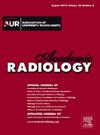用于区分胰腺黏液性囊性瘤和浆液性囊性瘤的放射线组学:系统综述和元分析。
IF 3.8
2区 医学
Q1 RADIOLOGY, NUCLEAR MEDICINE & MEDICAL IMAGING
引用次数: 0
摘要
背景:由于胰腺囊性肿瘤(PCN)目前的治疗标准不同,这些治疗方法可以在不同程度上影响生活质量,因此明确的术前诊断必须可靠。目前的诊断方法,特别是传统的横断面成像技术,面临一定的局限性。但放射组学已被证明对一系列疾病具有很高的诊断准确性。目的对利用放射组学技术鉴别黏液性囊性肿瘤(Mucinous Cystic Neoplasm, MCN)与浆液性囊性肿瘤(Serous Cystic Neoplasm, SCN)的文献进行综述。方法:本研究综合检索Pubmed、Scopus和Web of Science数据库,对使用放射组学区分MCN和SCN的研究进行meta分析。采用诊断准确性研究质量评价方法,结合敏感性、特异性、诊断优势比和总受试者工作特征(SROC)曲线分析评估偏倚风险。结果:8项研究共纳入884例患者,包括365例MCN和519例SCN。meta分析发现放射组学鉴定MCN和SCN具有较高的敏感性和特异性,综合敏感性和特异性分别为0.84(0.82-0.87)和0.82(0.79-0.84)。阳性似然比(PLR)为5.61(3.72,8.47),阴性似然比(NLR)为0.14(0.09-0.26)。绘制SROC曲线下面积(AUC)为0.93。通过漏斗图分析未发现显著的发表偏倚风险。从感兴趣体积(VOI)提取特征或在放射组学模型中使用人工智能分类器的性能优于使用感兴趣区域(ROI)或不使用人工智能分类器的协议。结论:该荟萃分析表明放射组学在区分MCN和SCN方面具有很高的敏感性和特异性,并且有可能成为一种可靠的诊断工具。本文章由计算机程序翻译,如有差异,请以英文原文为准。
Radiomics for Differentiating Pancreatic Mucinous Cystic Neoplasm from Serous Cystic Neoplasm: Systematic Review and Meta-Analysis
Background
As pancreatic cystic neoplasms (PCN) differ in current standard of care, and these treatments can affect quality of life to varying degrees, a definitive preoperative diagnosis must be reliable. Current diagnostic approaches, specifically traditional cross-sectional imaging techniques, face certain limitations. But radiomics has been shown to have high diagnostic accuracy across a range of diseases. Objective to conduct a comprehensive review of the literature on the use of radiomics to differentiate Mucinous Cystic Neoplasm (MCN) from Serous Cystic Neoplasm (SCN).
Methods
This study was comprehensively searched in Pubmed, Scopus and Web of Science databases for meta-analysis of studies that used radiomics to distinguish MCN from SCN. Risk of bias was assessed using the diagnostic accuracy study quality assessment method and combined with sensitivity, specificity, diagnostic odds ratio, and summary receiver operating characteristic (SROC)curve analysis.
Results
A total of 884 patients from 8 studies were included in this analysis, including 365 MCN and 519 SCN. The Meta-analysis found that radiomics identified MCN and SCN with high sensitivity and specificity, with combined sensitivity and specificity of 0.84(0.82–0.87) and 0.82(0.79–0.84). The positive likelihood ratio (PLR) and the negative likelihood ratio (NLR) are 5.61(3.72, 8.47) and 0.14(0.09–0.26). In addition, the area under the SROC curve (AUC) was drawn at 0.93. No significant risk of publication bias was detected through the funnel plot analysis. The performances of feature extraction from the volume of interest (VOI) or Using AI classifier in the radiomics models were superior to those of protocols employing region of interest (ROI) or absence of AI classifier.
Conclusion
This meta-analysis demonstrates that radiomics exhibits high sensitivity and specificity in distinguishing between MCN and SCN, and has the potential to become a reliable diagnostic tool for their identification.
求助全文
通过发布文献求助,成功后即可免费获取论文全文。
去求助
来源期刊

Academic Radiology
医学-核医学
CiteScore
7.60
自引率
10.40%
发文量
432
审稿时长
18 days
期刊介绍:
Academic Radiology publishes original reports of clinical and laboratory investigations in diagnostic imaging, the diagnostic use of radioactive isotopes, computed tomography, positron emission tomography, magnetic resonance imaging, ultrasound, digital subtraction angiography, image-guided interventions and related techniques. It also includes brief technical reports describing original observations, techniques, and instrumental developments; state-of-the-art reports on clinical issues, new technology and other topics of current medical importance; meta-analyses; scientific studies and opinions on radiologic education; and letters to the Editor.
 求助内容:
求助内容: 应助结果提醒方式:
应助结果提醒方式:


